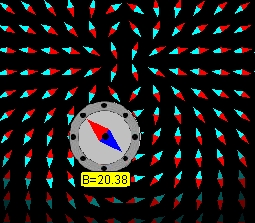Screen shot of the
magnetic dipole field
and compass.
Magnetic Multipole Field Model
The EJS Magnetic Multipole
Field Model shows the field of a magnetic dipole
or quadrupole
with little compasses
that indicate direction and relative field strength. A slider changes
the angular orientation of the dipole and a movable
compass shows
the magnetic field direction and magnitude. Compass values can be
recorded into a
data table and analyzed using a built-in data analysis
tool. Users
can examine and edit
the model if Ejs is
installed.
Exercises:
- Run the simulation of a
dipole. Move the
compass around in the magnetic field of the dipole (sitting on the
origin) and observe the value of the magnetic field. What direction is
the dipole oriented on this simulation (x-axis or y-axis)? How can you
tell? If this dipole were generated by a current carrying
loop, how would it be oriented on the simulation (draw a diagram)?
Change the angular orientation of the dipole (or current carrying loop)
and describe what happens.
- The magnetic field decreases
as you move away from the dipole (origin). Along the x-axis does it
decrease as 1/x, 1/x2,
1/x3, 1/x4?
In order to find out, move the compass along the x-axis and record the
field values in the Data
Table. (do not make measurements too close to the dipole which
is at the origin). Try to find a
good fit for the data. Note: Clicking on the Wrench
button
will open up a DataTool
with all your recorded data in columns. You may need to move the
columns around (drag the columns in the DataTool)
to Fit
the data (the DataTool
only fits the data in the first two columns). You will need to input
different equations in the Fit
Builder. For example, if you
want to fit the data to a/x2
(and have the program automatically find the value of a), double-click in the Fit Equation
box. Edit the fit equation from a*x+b to a/x^2 and
since you are only fiting one parameter (named "a"),
under Parameters,
highlight "b"
and cut it and then type your new Function
under = a/x^2.
Be sure you have
recorded enough data to be confident
that you know how the field drops off as a function of x.
- How does the field drop off
in the y-direction? (Clear the x-axis data and record magnetic field
data for the y-axis.)
- A quadrupole is constructed
from two dipoles (pointing in
opposite directions). How does the field drop off for a quadrupole? To
answer this,
record an appropriate number of data points (how many do you think are
necessary?) and fit the data.
- Adding more dipoles does not necessarily change the way the field
decreases as a function of position. Choose one of the configurations
of multiple
dipoles. The yellow arrows show the position and
orientation of the dipoles. How does the field along the x-axis
decrease as a function
of position for one of these? (Again, do not try to measure the field
right on top of one of the dipoles.) Is it closer to a dipole or
quadrupole field?
- How does the magnetic dipole compare with the electric dipole?
magnetic quadrupole compare with electric quadrupole? (Check Electric
Multipole
Model for comparison.)
References:
- Giancoli, Physics
for Scientists and Engineers,
4th
edition, Chapter 27
(2008).
Credits:
The Magnet Multipole
Field Model was
created by Wolfgang Christian and Francisco Esquembre and modified by
Anne J Cox
using the Easy Java Simulations (EJS) authoring and modeling
tool. Exercises written by Anne J Cox.
You can examine and modify a
compiled EJS model if you run the
program by double clicking on the model's jar file.
Right-click
within the running program and select "Open EJS Model" from the pop-up
menu to copy the model's XML description into EJS. You must,
of
course, have EJS installed on your computer.
Information about EJS is
available at: <http://www.um.es/fem/Ejs/>
and in the OSP ComPADRE collection <http://www.compadre.org/OSP/>.

